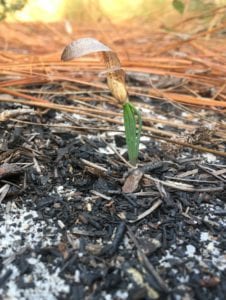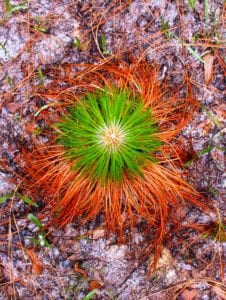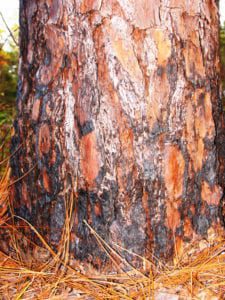The Ecosystem
Built by Fire
Frequent, low intensity, and often large scale, surface fires were the dominant factor in shaping the longleaf pine ecosystems across the historical range. This frequent fire regime, over generations, selected for longleaf pine’s fire-resistant attributes.
Seeds & Seedlings
Fire consumes litter on the forest floor, creating optimal conditions for germination. While longleaf seeds can germinate almost anywhere (on rocks, logs, forest mulch), they survive best on mineral soil. New germinants are susceptible to fire, however, until reaching the grass stage.
Grass Stage
Grass stage longleaf focus their growth underground in their roots while their long, dense needles protect the growth bud above ground. When a fire occurs, any burned or scorched needles will be quickly replaced with new growth. During the grass stage, longleaf pine seedlings are very resistant to fire damage.
“Rocket” Stage
Once longleaf initiates height growth, it grows rapidly in a short period of time, securing an advantageous position to gather sunlight. As it grows, newly emerged ‘candles’ may be vulnerable to damage until new (and protective) needles develop or the growing tip moves above typical flame heights. During the rocket stage, longleaf pine trees are also slightly more vulnerable to fire until its bark thickens for sufficient insulation.
Fire Resistant, Not Fire-Proof
After longleaf reaches 8 feet in height and about 2 inches in diameter at ground level, it becomes very robust and resistant to fire damage. On mature trees, thick plates of bark protect the inner wood from surface fires. Lower pine limbs are thermally pruned, keeping the canopy above most flame heights. Once established, longleaf needle litter promotes subsequent fires by providing fine fuels to carry fire across the forest floor. Of course, no tree is fire-proof, and longleaf pines are susceptible to fire injury during certain life-stages and when stressed by other environmental conditions (like drought, pests, or disease).
A Fire Forest
Longleaf pines are just one species in southeastern ecosystems adapted to frequent, low-intensity fires. Plants and wildlife alike utilize different strategies to survive and thrive in regularly burned habitats. See this response in action in the Perennial Forest Story - a visual journey of one forest following a prescribed fire.









